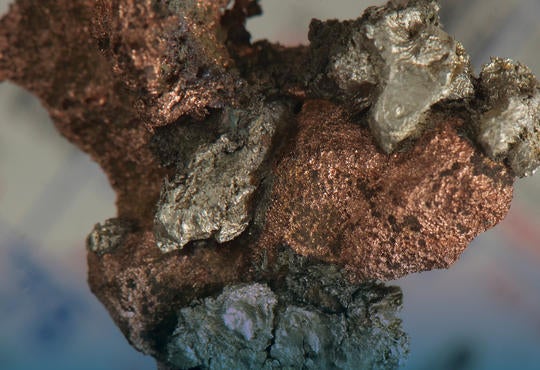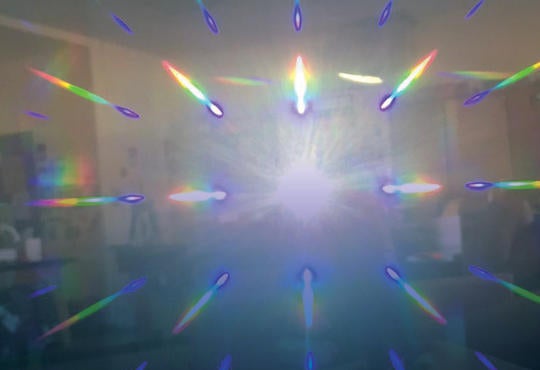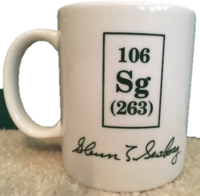 Glenn T. Seaborg was the science advisor to seven U.S. Presidents (Eisenhower, Kennedy, Johnson, Nixon, Reagan, Bush and Clinton). This final report for the ACT2 signature-mug series includes Seaborg's contributions and those of some select members of his extended research group: Segrè, Ghiorso, and Morgan. Others in the Seaborg group, Choppin and Oganessian, were previously discussed in Texas connections — September 2016, pages 14-15. The influence of Seaborg continues today. Signatures from this group are originals except Segrè.
Glenn T. Seaborg was the science advisor to seven U.S. Presidents (Eisenhower, Kennedy, Johnson, Nixon, Reagan, Bush and Clinton). This final report for the ACT2 signature-mug series includes Seaborg's contributions and those of some select members of his extended research group: Segrè, Ghiorso, and Morgan. Others in the Seaborg group, Choppin and Oganessian, were previously discussed in Texas connections — September 2016, pages 14-15. The influence of Seaborg continues today. Signatures from this group are originals except Segrè.
Seaborg was valedictorian of his high school graduating class in California. He matriculated to the University of California Los Angeles (UCLA) for his first degree in chemistry and then to Berkeley where he earned his PhD (1937) after studying under G. N. Lewis (chemistry) and Ernest Lawrence (physics). In 1941 plutonium, named by a young girl for the planet Pluto, was added to the periodic table. Seaborg could have gone with the symbol Pl, but he decided on Pu — pee-ewe as he frequently emphasized.
During WWII he and his group made several discoveries that were determined to be "top secret" by the U.S. government and were therefore not released to the world until the war ended. He was able to isolate plutonium-239, which had nuclear power/weapon potential. In 1942 Seaborg, Gofman and Stoughton discovered uranium-233, the fissile isotope of uranium that is bred from thorium-232 as part of the thorium fuel cycle. This separation ultimately led to the use of thorium as a source of nuclear fuel that today is used in LFTRs (Liquid Fluoride Thorium Reactors) that have no risk of reaching a critical mass. In April 1942, Seaborg took a leave of absence from Berkeley to head the Manhattan Project under the bleachers of Stagg Field at the University of Chicago. The goal of the project was to isolate enough plutonium-239 in order to develop an atomic weapon before Germany did. Seaborg described plutonium as a very unusual element due to having five forms in the solid state and the only element that can exist in aqueous solutions in four different oxidation states.
In 1951 he received the Nobel Prize with McMillan for the synthesis, discovery and investigation of the transuranium elements. His suggestion to pull the lanthanide and actinide series from the body of the periodic table was met with great caution. Many of his associates felt that he would be ridiculed for doing so, but he persevered and the rest is history. Seaborg was the only scientist to have an element (Sg, seaborgium) named for him while he was still living until 2016, when Oganessian likewise received this recognition. When asked what he might have done if he had not gone into nuclear synthesis research, he said, "I would have tried to play professional football." (He was 6' 4" and an avid football fan—attending all the football games he could as Berkeley's Chancellor.)
Seaborg held some very pointed views on the training of teachers. At his ACS memorial service held at the Fall 1999 National Meeting, a VCR-taped interview was distributed. Taken from his words:
- science teachers should be educated/hold degrees in the disciplines (like chemistry, physics, biology, etc.) without having to go through the "riggamaroo" —describes silliness and outlandish ideas — of the teaching-methods courses;
- massive amounts of money should be infused into the pre-college level schools; and
- more role models — like those of various minority groups — are needed and should be hired for our schools.
He was a very personable, intellectual scientist who gave great latitude to his group, including his graduate students. He was also known for noting that nuclear medicine has saved more lives than nuclear weapons have taken.
Emillio Segrè was educated in Italy and worked un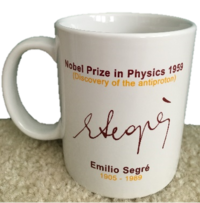 der Fermi. He discovered technetium (the first man-made element), astatine and helped Seaborg with the discovery of plutonium. In 1938 he was fired from his position at the University of Palermo because the fascist government of Italy under Mussolini deemed that Jewish scientists could not hold such posts. Segrè emigrated to the U.S. to escape the increasing anti-Semitism in Europe prior to WWII. He also worked at Berkeley and at Los Alamos on the Manhattan Project. By 1944 he became a citizen of the USA. As a professor of physics at Berkeley, he discovered the antiproton, a subatomic antiparticle, for which he was awarded the 1959 Nobel Prize in Physics. He died suddenly while taking his daily walk in Lafayette, California on April 22, 1989.
der Fermi. He discovered technetium (the first man-made element), astatine and helped Seaborg with the discovery of plutonium. In 1938 he was fired from his position at the University of Palermo because the fascist government of Italy under Mussolini deemed that Jewish scientists could not hold such posts. Segrè emigrated to the U.S. to escape the increasing anti-Semitism in Europe prior to WWII. He also worked at Berkeley and at Los Alamos on the Manhattan Project. By 1944 he became a citizen of the USA. As a professor of physics at Berkeley, he discovered the antiproton, a subatomic antiparticle, for which he was awarded the 1959 Nobel Prize in Physics. He died suddenly while taking his daily walk in Lafayette, California on April 22, 1989.
After receiving his BSc in electrical engineering from the University of 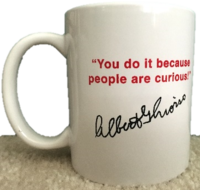 California, Berkeley in 1937, Albert Ghiorso worked with Seaborg starting in 1941, and subsequently moved with him to Chicago to work on the Manhattan Project. In the mid-1950s, it became clear that to extend the periodic chart any further, a new accelerator would be needed. Under his direction, the Berkeley Heavy Ion Linear Accelerator (HILAC) was built. At the time his signature mug was distributed (2002), Albert Ghiorso was the #1 nuclear scientist in the world as to the number of elements he synthesized in the cyclotron. Not only did this non-PhD scientist/technician work with Seaborg on discovering 12 transplutonium elements, he was a prolific inventor of the nuclear technology that made these syntheses possible. He made the recommendation for element 106 to be named seaborgium. The name was accepted by IUPAC only after extensive debate about naming an element after a living person.
California, Berkeley in 1937, Albert Ghiorso worked with Seaborg starting in 1941, and subsequently moved with him to Chicago to work on the Manhattan Project. In the mid-1950s, it became clear that to extend the periodic chart any further, a new accelerator would be needed. Under his direction, the Berkeley Heavy Ion Linear Accelerator (HILAC) was built. At the time his signature mug was distributed (2002), Albert Ghiorso was the #1 nuclear scientist in the world as to the number of elements he synthesized in the cyclotron. Not only did this non-PhD scientist/technician work with Seaborg on discovering 12 transplutonium elements, he was a prolific inventor of the nuclear technology that made these syntheses possible. He made the recommendation for element 106 to be named seaborgium. The name was accepted by IUPAC only after extensive debate about naming an element after a living person.
In 1999 evidence for two superheavy elements — elements 116 and 118 — was published by a group at Berkeley. The discovery group intended to propose the name ghiorsium for element 118, but eventually the data were found to have been compromised and subsequently the claims were withdrawn. This honor has now been extended to the still-living Oganessian with oganesson (see September 2016, pages 14-15). IUPAC rules will not allow for the resubmission of a once-proposed name, so no element can be named to honor Ghiorso in the future, unless the rules are amended. This is unfortunate for a scientist who devoted five decades of his life to furthering the advancement of element synthesis. Ghiorso was very active in educational outreach, including appearances on science-related television programs, meeting with students in classrooms, enabling visits to the laboratory at Berkeley and writing popular reviews of the search for new elements. He is famous among his colleagues for his endless stream of creative “doodles,” which define an art form suggestive of fractals. Oganessian stated, "Albert Ghiorso can be placed next to Professor Seaborg. His contributions to this field of science, as a talented physicist-experimenter, are difficult to overestimate."
We end where we started with our first original-signature mug honoring L.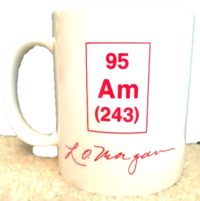 O. (Tom) Morgan, Professor Emeritus, The University of Texas at Austin (UT). Morgan worked under Seaborg as a graduate student and is credited with the synthesis of americium (Am) in Chicago in 1944. Morgan, born in Oklahoma, received his master's degree at UT. Because he had helped synthesize americium, Seaborg gave him the privilege of naming it. The first two names submitted to IUPAC were rejected. He had suggested "delirium" (from Latin for madness) and "pandemonium" (from Greek for all demons or hell) because of the difficulties encountered when attempting the separation of curium and americium. Seaborg told this Berkeley graduate student that if he wanted to name this element then come up with a better name. He did, and americium was approved by IUPAC in 1945. Am-241 is used in household smoke detectors that possess a very small quantity as americium dioxide, AmO2. Morgan was a member of the UT Austin faculty in the Department of Chemistry for 46 years (1947-1993).
O. (Tom) Morgan, Professor Emeritus, The University of Texas at Austin (UT). Morgan worked under Seaborg as a graduate student and is credited with the synthesis of americium (Am) in Chicago in 1944. Morgan, born in Oklahoma, received his master's degree at UT. Because he had helped synthesize americium, Seaborg gave him the privilege of naming it. The first two names submitted to IUPAC were rejected. He had suggested "delirium" (from Latin for madness) and "pandemonium" (from Greek for all demons or hell) because of the difficulties encountered when attempting the separation of curium and americium. Seaborg told this Berkeley graduate student that if he wanted to name this element then come up with a better name. He did, and americium was approved by IUPAC in 1945. Am-241 is used in household smoke detectors that possess a very small quantity as americium dioxide, AmO2. Morgan was a member of the UT Austin faculty in the Department of Chemistry for 46 years (1947-1993).
See the ACT2 website https://sites.google.com/site/
act2tx/home/signature-mugs for the complete collection of the mugs and their descriptions. We extend great Texas hugs and thank yous to all the scientists who have made this series possible.



